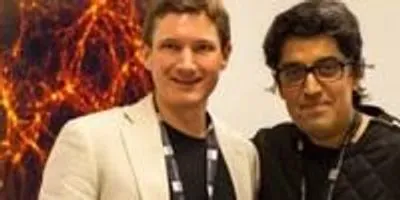 Benedikt Diemer (left), PhD candidate in astrophysics, and Isaac Facio, master of fine arts candidate at SAIC, collaborated on “The Fabric of the Universe,” a project that translated computer simulations of dark matter into 3-D textiles.Photo courtesy of Julie Marie LemonThe goal of providing these collaborative grants is “to test the idea that different domains of knowing and knowledge—arts, science and culture—can enrich and influence each discipline’s particular questions, tools, methodologies and specific curiosities,” said Julie Marie Lemon, the program’s director and curator.
Benedikt Diemer (left), PhD candidate in astrophysics, and Isaac Facio, master of fine arts candidate at SAIC, collaborated on “The Fabric of the Universe,” a project that translated computer simulations of dark matter into 3-D textiles.Photo courtesy of Julie Marie LemonThe goal of providing these collaborative grants is “to test the idea that different domains of knowing and knowledge—arts, science and culture—can enrich and influence each discipline’s particular questions, tools, methodologies and specific curiosities,” said Julie Marie Lemon, the program’s director and curator.
The collaborative efforts between the students of arts, science and culture resulted in creative projects that were presented in early May.
One of the projects was “The Fabric of the Universe,” created by Isaac Facio, a master of fine arts candidate in fiber and material studies at SAIC, and Benedikt Diemer, a University of Chicago PhD candidate in astrophysics. This project used computer simulations of dark matter and translated them into a more tangible form using three-dimensional textiles, resulting in a novel way of visualizing the structure of the universe.
Diemer said that the project has offered a new perspective for his research in astrophysics.
“Our project has caused me to look at my data in 3-D where I previously only made 2-D visualizations. This has definitely improved my understanding of the dark matter structures in my simulations,” he said.
As a testament to the novel insights offered by this project, “’The Fabric of the Universe” was awarded a grant from the renowned TextielLab, part of the TextielMuseum, in Tilburg, the Netherlands, to produce the fabric,” said Lemon, the program director.
Another project, “Syntax & Songbirds,” was created by Geoff Brookshire, a PhD candidate in psychology; Kyler Brown, a PhD candidate in computational neuroscience; and Marcelle Pierson, a PhD candidate in music history and theory.
This unusual grouping of student expertise led to a musical creation with classical instruments constrained by the biological and cognitive systems associated with birdsong. “It’s not classical instruments playing birdsong, it’s synthetic birds playing classical music,” Brown said. “We use the ‘sounds’ of the bird, not the ‘song.’”
Their efforts resulted in a full-length musical composition, which was played and recorded in its entirety during a free, public event from 2 to 4 p.m., Sunday, May 31 at the Logan Center Performance Penthouse, 915 E. 60th St. The event also included poetry by Hannah Brooks-Motl, PhD student in English; and a presentation on “Fiction Addition,” a documentary film by Anya Bershad, PhD candidate in neuroscience, and Bill Hutchison, PhD candidate in English.
The team members of “Syntax & Songbirds” found no shortage of new perspective through this collaboration of seemingly disparate fields. For Brown, the major lesson involved collaboration as a whole.
“The essence of collaboration requires giving up complete control of the project, and trusting the expertise of my collaborators,” Brown said.
Pierson also found a new understanding of her field.
“Composition is all about constraints, and the science informing this composition gave me a new and fascinating set of both possibilities and limitations,” she said.
Both of these projects exemplify the novel results of collaborations between arts and sciences, demonstrating the efficacy of offering such grants, Lemon said.
And each year, she noted, “the collaborations and the projects have become more and more sophisticated, and more students become interested in the initiative.”
The goal of providing these collaborative grants is “to test the idea that different domains of knowing and knowledge—arts, science and culture—can enrich and influence each discipline’s particular questions, tools, methodologies and specific curiosities,” said Julie Marie Lemon, the program’s director and curator.
The collaborative efforts between the students of arts, science and culture resulted in creative projects that were presented in early May.
To continue reading this article, sign up for FREE to

Membership is FREE and provides you with instant access to eNewsletters, digital publications, article archives, and more.



 Benedikt Diemer (left), PhD candidate in astrophysics, and Isaac Facio, master of fine arts candidate at SAIC, collaborated on “The Fabric of the Universe,” a project that translated computer simulations of dark matter into 3-D textiles.
Benedikt Diemer (left), PhD candidate in astrophysics, and Isaac Facio, master of fine arts candidate at SAIC, collaborated on “The Fabric of the Universe,” a project that translated computer simulations of dark matter into 3-D textiles.







